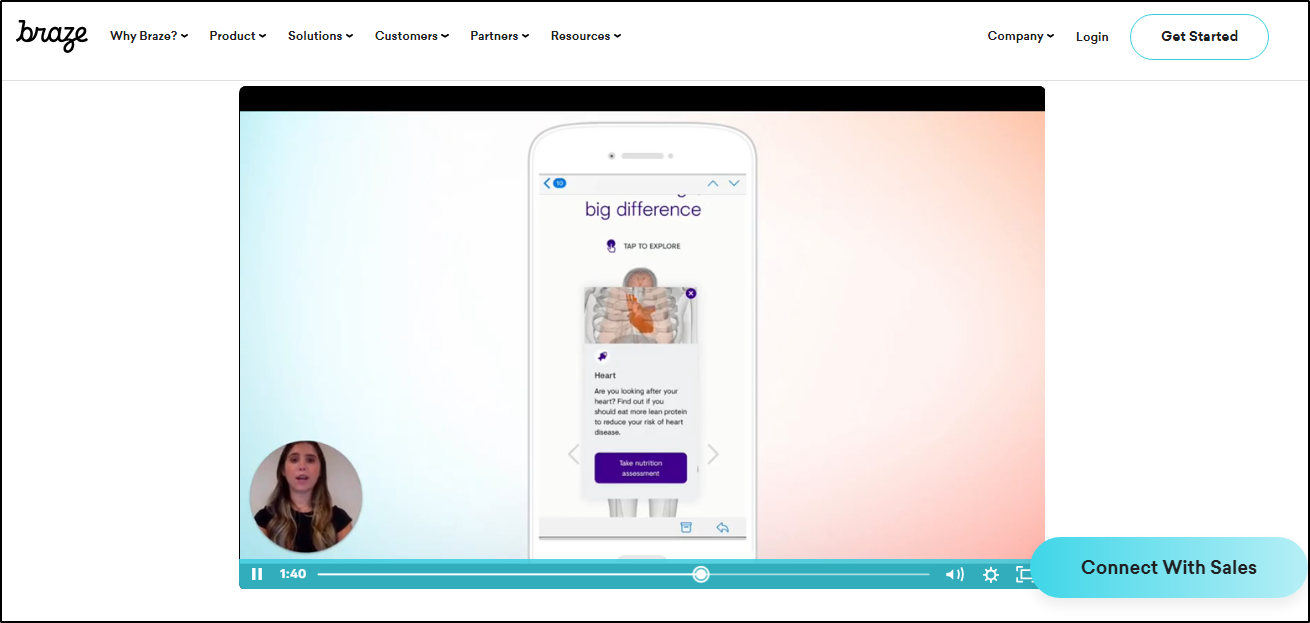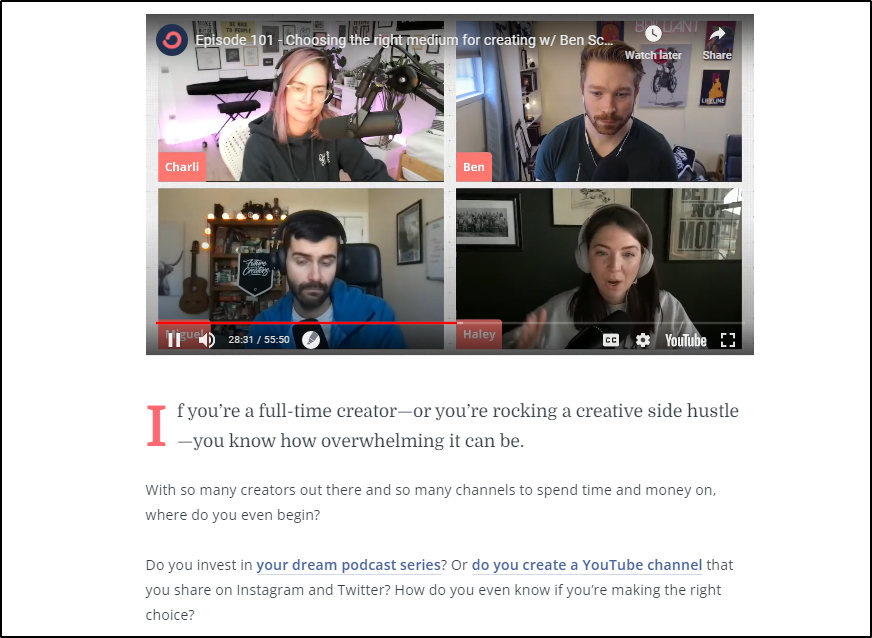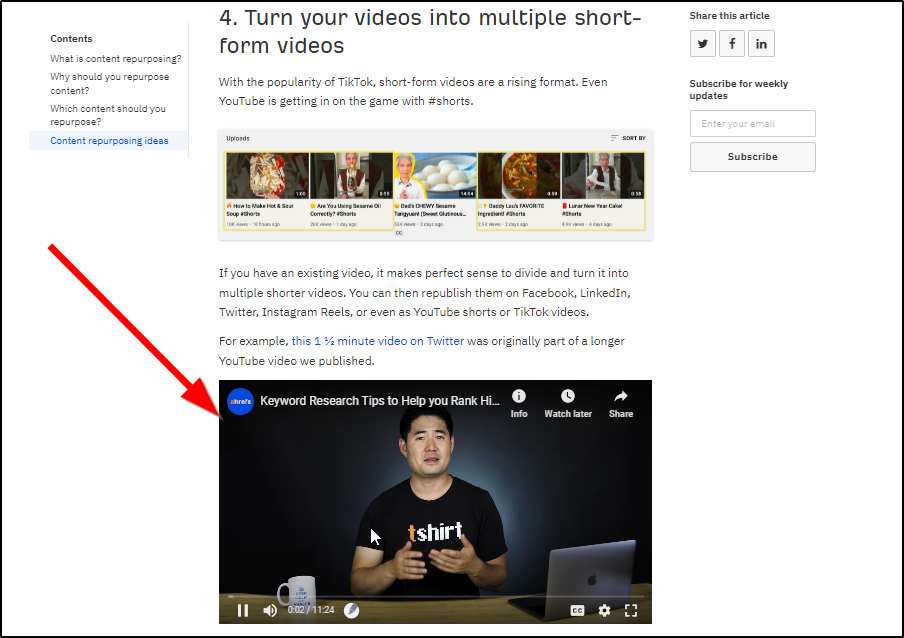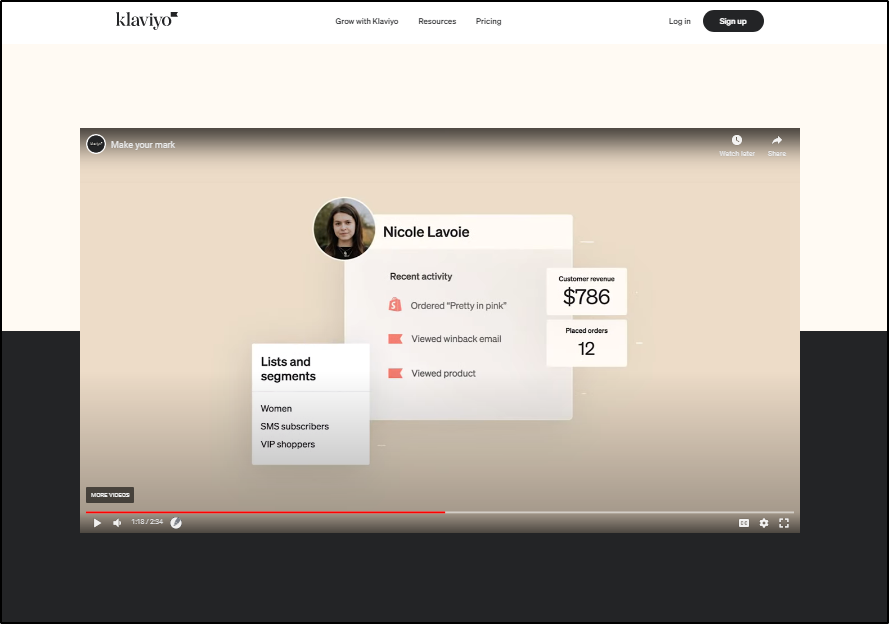Video is the most engaging and fastest-growing digital content type (you already know that).
You also know that you should start investing in video content creation because most of your top competitors are already doing it.
But you don’t know where to start.
This is precisely why we’ve written this detailed video marketing strategy guide. Whether you’re marketing a SaaS product or offering services as a consultant, this beginner’s guide will tell you everything you need to get started with video content marketing.
What Is Video Marketing?
Video marketing uses video content to build brand authority, increase audience engagement, attract more traffic, and market your products or services to get more leads and customers.
It also includes creating videos to drive repeat sales by helping your customers get more value from your product, answering frequently asked questions, and building a personal connection with them.
Doopoll’s welcome emails are an excellent example of how video marketing helps you create a stronger bond with your customers and ultimately increase sales. Marc, Doopoll’s CEO, sent welcome emails with personalized Loom videos to a select group of free users. This increased the free to paid conversion rate by 2.13%.
Another SaaS, Qwilr, increased its pre-sales email conversion rate by 37% in three months by using Loom videos that explained its product features to the prospects.
According to a recent study, most marketers plan to increase their investment in video content creation in the coming years.

But it also means there’s more competition for your audience’s attention. Your competitors are investing heavily in video content and targeting your audience through multiple channels and platforms.
This is why you need a well-researched video marketing strategy that considers the needs and preferences of your audience to help you create engaging and result-oriented video content.
Why Video Marketing Is Important For Businesses
Video isn’t a new content format. But the mainstreaming of high-quality smartphone cameras, video recording and editing software, and dedicated digital video platforms means it’s more important than ever for businesses to invest in video content. Research even shows that most consumers now expect their favorite brands to create videos regularly.
According to Statista, 62% of internet users watch more than 5 hours of online video content every week, while 27.2% of consumers watch 10+ hours of video per week. These stats aren’t surprising because humans are primarily visual learners. Our brains find it easier to process and interpret visuals than plain text.
According to VWO, adding a video to your landing page can increase conversions by 86%. This also explains why 79% of B2B customers have purchased software because of explainer videos and product demos.
In short, video content helps brands communicate more clearly with their prospects, leads, and customers. This results in persuasive marketing content, higher conversions, and more meaningful brand engagement.
Video Marketing Examples: 6 Ways Brands Use Video Content For Marketing
There are numerous ways to use video content in your brand’s marketing and user engagement strategy.
Let’s quickly discuss some of the popular ways brands are doing it.
Show Users What Your Product Can Do
People buy tools and software to solve problems and fulfill needs, not for fancy features. So, instead of marketing your features all the time, create actionable videos that show users what they can do with your product.
For example, Braze, a leading customer engagement tool and a happy Loom customer, transformed its content marketing strategy by creating dozens of Loom videos showing the different ways users could benefit from its platform.

Asana, one of the top project management platforms, also uses product tutorial videos to great effect. Its YouTube channel has numerous videos with step-by-step guidelines to achieving different business goals with Asana features.
Such videos not only attract traffic and leads but also help your customers get more value from your product. This ultimately creates more customer success stories and increases your retention rates.
Embed Videos In Blog Content
Adding relevant videos to your blog posts is a low-hanging fruit that can immediately improve your brand’s SEO and content marketing. Apart from making your content more valuable, it keeps readers engaged longer and increases your site’s average session duration, a critical SEO ranking factor.
ConvertKit, an email marketing platform for creators, regularly includes relevant videos in its blog posts from its YouTube channel.

Ahrefs, a leading SEO company and among the best content marketing practitioners, uses relevant videos in almost every blog post.

Embedding videos in your content also helps you rank for video searches and drive additional traffic to your blog content.
Create Teardowns To Build Authority
Product teardown and audit videos are the fastest way to build your authority as an agency, consultant, or service provider. For example, here’s a detailed Loom video of a landing page teardown by a copywriting consultant.
The video audits the landing page, describes its strengths and weaknesses and recommends alternate strategies to make it more effective. Such content immediately establishes you as the go-to person (or company) for your services. SaaS companies can also use this approach to create valuable content for their customers and target audience to increase brand awareness.
Segonu Software, an email marketing automation tool for Shopify, does email teardowns on its YouTube channel.
Create Customer Testimonials And Success Stories
Video testimonials are another excellent way to use video content in your marketing strategy. Seeing happy customers describe their journey with your product and how it solved their problems has a much greater impact than simple text reviews.
This testimonial video by Dropbox is a great example.
For companies with limited budgets or customers who’re reluctant to get on camera, Loom is an excellent option for creating video testimonials. It’s also ideal for testimonials where customers want to show their results via screen sharing.
Engage Leads And Customers With Personalized Content
Research shows that 92% of buyers prefer customized content that addresses their specific needs and challenges. Imagine the impact of a personalized video message that talks directly to the lead and responds to their questions.
This is precisely how Loom’s account manager convinced Postclick’s CEO to try our product.
Personalized videos such as birthday messages from account managers also go a long way in strengthening your customer relationships.
These were just some of the ways businesses can use video content in their marketing campaigns. But let’s now discuss video marketing strategy in more detail.
How To Create A Video Marketing Strategy
Video is the most engaging content format. But you won’t get results from it without creating a comprehensive video marketing strategy that considers your target audience's needs, problems, challenges, and opportunities.
Let’s discuss the steps you need to follow to create such a strategy.
1. Define Your Video Marketing Goals
Like any other content type, videos can help you achieve various business goals and objectives. But you need to be clear about them before you start creating content. For example, most SaaS companies use videos to help prospects understand their product features. But brands also use videos for traffic generation at the top of the marketing funnel. This video by Mailchimp on eCommerce holiday sales strategies is an excellent example.
However, most SaaS companies still use videos for product demos and walkthroughs during the sales process.
Defining your goals is crucial because it determines the types of videos you create and the platforms you choose to publish them. For example, if you want your videos to drive traffic to your site, targeting informational topics and publishing on public platforms like YouTube, Facebook, or LinkedIn is the right strategy.
So before investing in video content production, ask yourself what you want to achieve with your content? What do you want the viewer to do after watching your video? How does it bring them closer to becoming your customers?
2. Build Your Video Marketing Funnel
To create a comprehensive video marketing strategy, you need to understand the various stages of the marketing funnel.
Top Of The Funnel (ToFu)
ToFu content is designed for people looking to learn more about the problem your product solves. Most of the video ideas in this stage are built around informational topics that discuss the fundamentals of your niche.
This beginner’s guide to SEO is a good example of ToFu content.
ToFu content targets informational keywords that attract the most traffic. So if your goal is traffic generation, create informative content that targets the most common questions of your audience.
Middle Of The Funnel (MoFu)
Middle of the funnel content is designed for people exploring how different products solve their problems. The videos in this funnel stage show a more direct relationship between your product features and benefits.
This keyword research guide by Ubersuggest is an excellent example.
It dives seep into Ubersuggest features and shows how users can find profitable keywords for their SEO and content marketing campaigns.
MoFu content is ideal for people already familiar with your brand and helps you bring them closer to the purchase decision.
It also helps your customers get more value from your product by using its features to its full potential.
Bottom Of The Funnel (BoFu)
BoFu content is designed to convert leads into customers. It positions your product as the best solution for the users by comparing its pricing and features with other products.
This Kajabi vs. LearnWorlds video by Kajabi is an excellent example.
Webinars and product demos are also very effective video formats in the BoFu stage for converting unsure leads into customers.
3. Understand Your Audience Needs To Find Topics
Now that you understand how the video marketing funnel works, it’s time to find video content ideas for every funnel stage. This is where audience research comes in. If you already have a popular blog or active social media profile, you can easily find engaging video topics by analyzing your best-performing content.
For example, you could dive into your Google Analytics account to find the blog posts with the most visitors and the longest session duration and turn them into videos.
But if you don’t have such insights, here are a few ways to understand what your audience wants to learn about.
Competitor Analysis
What topics do your competitors frequently talk about? What are their most popular blog posts, social media content, and videos? Answering these questions will help you uncover the topics your audience wants to learn more about.
Customer Review Sites
Review sites like G2, Capterra, Trustpilot, etc., can be an excellent source of middle and bottom of the funnel content ideas. Head over to your competitor’s user reviews and look for two and three star reviews to find the most frequent customer complaints.
If you’re a competitor, creating a video on how your product simplifies this problem can help you attract customers and leads.
Sales & Customer Support Teams
Your sales and support staff routinely interact with your customers and listen to their problems. They’re your best source for customer insights and can help you find unique video content ideas for every stage of the video marketing funnel.
For example, your support teams can tell you the most frequent problems customers face while using your product. Similarly, your sales teams can tell you the most common objections leads, and prospects have during the sales process.
Use their feedback to create valuable content that answers customer queries and helps them use your product to its full potential.
YouTube And Google Search Analysis
Google Search and YouTube are the world’s top two search engines. And they can tell you a lot about your audience preferences.
1. Enter your topic in the search bar to get YouTube search suggestions.
Now add an asterisk (*) before your keyword to get more ideas.
Now add a preposition after your keyword to get more unique suggestions.
These techniques work in Google Search as well and can help you uncover numerous topics for your video marketing strategy.
2. Search for your topic in Google Search and scroll down to People Also Ask to find the most frequently searched questions.
Scroll further down to related searched for more ideas.
These questions and keywords are great starting points for your research and can help you find numerous content ideas for your video strategy.
Forums And Social Media Groups
Industry-specific discussion forums, Slack groups, and social media groups are research goldmines for content creators.
Join as many of them as possible to gain valuable insights into your customer needs and uncover the real problems they’re facing.
4. Choose The Right Video Types For Your Business
Now that you’ve identified your video marketing goals and found content ideas for different stages of the marketing funnel, it’s time to decide your video style and format.
Here are some of the most commonly used video types.
Informational Videos
These videos answer the most frequent questions of your audience and help you demonstrate your expertise. For best results, focus on only one question per video. If you want to tackle a more complex topic, break it down into multiple short videos to make them easier to understand.
This video by Helpscout, a leading helpdesk solution, is an excellent example.
Personalized Messages
Personalized video messages help you stand out during the sales process and also allow you to build stronger customer relationships. Using Loom, you can quickly record engaging video messages that show your customers that you care (remember Doopoll’s example I shared earlier in the article?)
Product Tutorials
Tutorial videos help users understand your product features and use them to their full potential. These videos increase customer satisfaction by helping them get more value from your product and ultimately improve your retention rate. In addition, they help prospects get an inside view of your product and decide if it’s the right solution for their business needs.
This video by Canva is a good example.
Product Demos
Product demo videos allow you to show prospects how your product can solve their problems. These are interactive videos perfect for converting leads into customers. With Loom, you can lead with a personalized product demo in your sales process to build early rapport and answer your prospect’s objections.
Explainer Videos
Explainer videos are short marketing videos that quickly explain your product’s value proposition. Companies often use explainer videos on their website’s homepage to introduce their product to new visitors.
For example, Klaviyo’s homepage has a high-quality explainer video that perfectly describes its platform in just a few minutes.

Video Sales Letters (VSL)
Video Sales Letters (VSLs) are sales videos that highlight your audience's pain points and pitch your product as the perfect solution. As the name suggests, VSLs are all about selling your product which is why they’re mainly used on sales pages.
Expert Interviews
People love listening to industry experts and influencers talk about different business problems and challenges. If you have a qualified team, you can run an in-house interview series where different in-house experts talk about the most common challenges of your audience. Or you could partner with experts and influencers to publish detailed interviews on various topics.
Brand Videos
Brand videos tell your brand’s story and give your customers an inside look at your company culture and the people behind it. These videos help you build a closer connection with your audience and add a human touch to your brand.
Shopify’s video on its journey from a startup to a multi-billion dollar company is an excellent example of a well-made brand video.
A comprehensive video marketing strategy can include all of these content types. But your choice would ultimately depend on your immediate marketing goals, content ideas, and production budgets.
5. Find The Best Platforms For Your Videos
The platforms you choose to publish your videos play a vital role in their success or failure. So let’s quickly discuss the different places you can publish your video content and their pros and cons.
Ultimately, your platform choice depends on your video’s goals and format. Most public video platforms are designed for top-of-the-funnel informational content. Use them to drive traffic to your site where you can engage users with more personalized middle-of-the-funnel content.
Apart from these platforms, you can use email to share links to personalized videos such as product demos and customer support and sales building content.
The Three Stages Of Video Content Production
So far, we’ve discussed the fundamentals of a video marketing strategy. But what are the different steps in creating video content? Your video production process can vary depending on your content format.
But generally, B2B video content production consists of the following stages.
Pre Production Planning
We’ve already talked about the planning and strategy part of video production in great detail. But let’s quickly discuss what you need before shooting a video.
Idea Generation
This is the most important step of video production planning that needs careful research and brainstorming. When finding ideas for your videos, ask yourself the following questions.
What is our business goal with this video? What do we want to achieve?
Who are we creating this video for?
What problems or topics do they care about?
What’s their biggest roadblock?
How can we answer their questions?
What video format do they engage with the most?
What platforms do they use for video content consumption?
What’s the next step we want the viewers to take after this video?
Having clear answers to these questions will help you find valuable content ideas that resonate with your audience.
Storyboard
The storyboard is where you describe the sequence of events in your video. Use it to explain how your video will progress and list all the scenes from it.
A storyboard can be as simple as a Google Docs file where you list down all the scenes and transitions of your video.
It comes in handy for storytelling videos such as explainer videos, brand videos, customer testimonials, and commercials.
Script Writing
Don’t underestimate the value of a well-written video script. Even if you’re creating a product demo recording, a personalized video message, or an informational video, having a script or at least a bulleted list of the points you plan to discuss can make your life a lot easier. But a formal script is necessary for brand videos, customer testimonials, and explainer videos.
An engaging script is conversational and consistent with your brand’s voice, with short sentences and uncomplicated words. For longer videos, create separate scripts for each scene but make sure they align with each other. For formal videos, you can hire freelance video scriptwriters to do the job for you. For regular sales conversations, bulleted pointers would suffice.
Team Finalization
Getting in front of the camera is scary for most people. So, you might struggle to find people in your company willing to act or present in your videos. If you have them, you’re lucky. But if you don’t, you can always hire experienced freelancers or video production companies to help you out.
Production
The production phase turns your idea into a reality. Here are the steps involved.
Video Production Software
You can’t produce a high-quality B2B video without the right tools and software. This is where Loom comes in. Whether you're creating a product demo, an informational video, product walkthroughs, customer testimonials, or personalized video messages, Loom is the easiest way to create high-quality videos from your computer.
For high-end videos such as commercials or brand stories, it’s better to outsource the work to a production company experienced in creating such content.
Shooting
“Write drunk, edit sober.” That’s a famous saying for writers, but it’s equally valid for video production. When creating a video, don’t try to be perfect on the first go. Instead, shoot your content without thinking about mistakes or retakes. Then, once you’re done, move to the post-production stage.
Post Production Editing
This is the stage where you convert ordinary content into high-quality professional videos.
Editing
Use the editing phase to remove all the unnecessary frames and mistakes during the production phase. This would help you improve your content flow which is critical since people have shorter attention spans these days.
Animation
Use animations to add a branded welcome screen, transitions between scenes, and other critical information to your videos, such as the presenter’s name, designation, and your company logo.
Sound And Music
The sound quality of your video is as important as the visuals. This is why you should use an external noise cancellation mic while recording your videos. In the editing phase, make sure your voice is audible and make adjustments to the sound levels if needed. You might also want to add background music or mix other sounds with your voice for some videos. If that’s the case, make sure any supporting audio tracks are at a significantly lower volume than your voice so that the viewers can easily hear you.
Add Calls To Action (CTAs)
Calls To Action (CTAs) are critical to achieving a positive ROI with your videos. For example, if you’re creating an explainer video for your product, your CTA could be a link to the free sign-up page. If you’re making a product demo video, your CTA could be booking a sales call.
Most video players don’t allow in-video CTAs. But Loom gives you this feature and makes your videos more conversion-driven.
You can add a URL CTA to your sign-up page, landing page, or any other link at the end of your video to drive conversions and measure the ROI of your content.
How To Create A Marketing Video With Loom
We've discussed all the critical elements of a video marketing strategy and how you can use it to grow your business. Before concluding this post, let me show you how you can create a marketing video with Loom. Compared to other video software and platforms, it’s super easy.
Step 1: Download Loom or Install The Chrome Extension
Sign up for a free Loom account.
Download and install Loom’s Chrome extension or desktop application for Windows or Mac. For this guide, we’ll show you how to use the Chrome extension since it’s easy and has all the necessary recording options.
Once you install and activate Loom’s Chrome extension, you’re ready to start recording.
Step 2: Upload Or Record A Video
Open Google Chrome.
To record a Loom video, click on its Chrome extension icon.
This opens Loom’s recording panel from where you can configure your video settings.
You can choose to record using both your system screen and camera, the screen only, or the camera only for your video. Similarly, you can select the audio source from the Recording Settings.
Loom also gives you the option to record your Chrome window, a specific tab, or your entire screen (desktop+any other apps). You can also explore more options in the Advanced Options section.
Once you’re satisfied with the settings, click Start Recording to begin your video.
You’ll see a small control panel during the recording, using which you can stop, pause, or delete your session.
Click the Stop button to finish the recording.
Step 4: Preview The Video
The moment you stop recording, Loom takes you to your video preview, where you can edit your content from the settings panel.
For example, click Video Preferences to choose how users engage with your videos. You can enable comments, replies, emojis, transcripts, and several other features.
You can also use the video preview section to add a CTA or trim your video to remove unnecessary parts.
Step 5: Copy The Video Link
When you’re ready to share your video with your prospects, clients, or team members, copy its link from the icon next to the Share button.
By default, anyone with your video’s link can view it. However, you can change this from the Share settings area.
You can change the privacy settings to specific users or people associated with your Loom workspace.
Once you’re satisfied with the privacy settings, copy the link and share it with anyone you want.
Step 6: Add it to your marketing materials
You can also add Loom videos to your landing pages, website, blog posts, or other marketing material by using its embed code.
You can access the embed code from the Share settings, where you can configure your video player’s dimensions and appearance.
To embed a video, copy the code from Loom and add it to your website, blog, landing page.
What Is Your Brand’s Video Marketing Strategy?
We’ve covered most of the fundamentals of a B2B video marketing strategy in this guide. As you can see, you don’t need to have a million-dollar budget to take advantage of the video marketing boom.
With Loom, you can quickly create highly engaging videos for every stage of the video marketing funnel to attract traffic, engage leads, and drive conversions.
Try Loom for free today to create your first interactive video.

